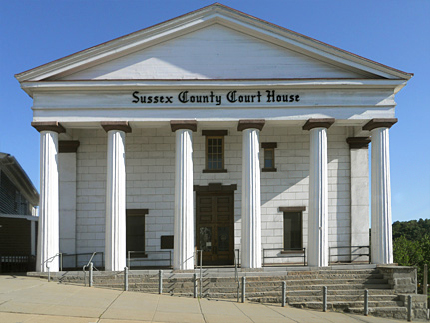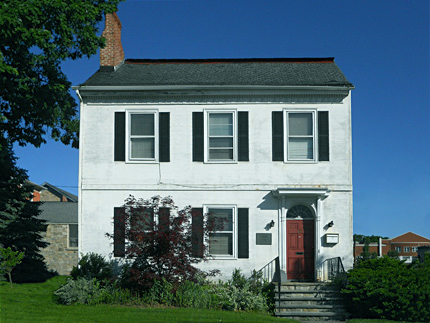



Sussex County Courthouse
3 High Street
Map / Directions to the Sussex County Courthouse
Map Directions to all Newton Revolutionary War Sites
The original Sussex County Courthouse was built in 1765 at this location. In 1847, a fire destroyed the inside of the building, and the current courthouse was built on the same spot, using some of the material from the original building. [1]
On May 27, 1780, a group of Loyalists led by James Moody made a raid on the courthouse and freed prisoners who were being held here. Loyalists were Americans who remained loyal to the British in the Revolutionary War. Moody was a Loyalist who had gained great notoriety for the many raids he led in New Jersey. [2]
General George Washington is known to have stopped at the courthouse on at least two occasions during the war: in November 1780 and July 1782. [3]



Thomas Anderson House
62 Main St.
Map / Directions to the Thomas Anderson House
Map / Directions to all Newton Revolutionary War Sites
This building was the home of Thomas Anderson, who served as an Assistant Deputy Quartermaster General during the Revolutionary War. [4] It is believed that General George Washington may have dined at this house when he was in Newton (as mentioned in the Sussex County Court House entry above). [5]
At that time of the Revolutionary War, this house stood a few hundred yards northeast of its current location and faced the Newton Green. It was moved to this location in 1869. It now serves as the office of the Christ Episcopal Church of Newton. [6]
Thomas Anderson died on May 29, 1805; he is buried in the Old Newton Burial Ground. (See next entry)



Old Newton Burial Ground
Main St. near Park Pl.
Behind McGuire Chevrolet
Cadillac
Map / Directions to the Old Newton Burial Ground
Map / Directions to all Newton Revolutionary War Sites
The Old Newton Burial Ground, which dates back to 1762 [7] contains the graves of Revolutionary War veterans, including: [8]
Thomas Anderson
(Died May 29, 1805, "in the 62nd year of his age.")
Assistant Deputy Quartermaster General
Lived at the Thomas Anderson House in Newton
Richard Boyd
(Died May 17, 1792; Aged 37)
Major
John Kays
(March 9, 1739 - July 13, 1829)
Lieutenant
See the Hardyston page for more
about Lt. Kays



Moody's Raids Marker
Dennis Branch of the Newton Library
101 Main Street
Map / Directions to the Moody's Raids Marker
Map / Directions to all Newton Revolutionary War Sites

1. ^ National Register of Historic Places / Inventory - Nomination Form for the Sussex County Courthouse; Item Number 8, Page 2 (Page 6 of the PDF)
Available as a PDF on the National Park Service website here2. ^ Contemporary accounts of the raid on the Sussex County Courthouse can be found in a short newspaper account which was published six weeks after the event, and in James Moody's own lengthier and more colorful account which appeared in a memoir he wrote in 1782. There are contradictions in details between the accounts, and the newspaper article does not even mention Moody by name.
Both of these accounts are available to be read online at the links below:
"We are informed, that on the night of the 21st..." The New-Jersey Journal, Vol. II., Numb. LXXII., July 5, 1780, reprinted in:
William Nelson, Editor, Archives of the State of New Jersey, Second Series, Vol. IV Extracts From American Newspapers Relating to New Jersey, Nov. 1, 1779 - Sept. 30, 1780 (Trenton: State Gazette Publishing Co., 1914) Page 476
Available to be read at the Internet Archive here
James Moody: With an Introduction and Notes by Charles I. Bushnell, Narrative of the Exertions and Sufferings of Lieut. James Moody, in Cause of Government Since the Year 1776 (New York: Privately Printed, 1865) Pages 21 - 27
Available to be read at the Internet Archive here
3. ^ John C. Fitzpatrick, George Washington's Accounts of Expenses While Commander-in-chief of the Continental Army, 1775-1783: Reproduced in Facsimile, with Annotations (Boston and New York: Houghton Mifflin Company: 1917) Pages 68-69 and 89
Available to be read at Google Books here4. ^ Plaque placed by the Society Daughters of Colonial Wars in the State of New Jersey in 1958.
5. ^ A tradition that Washington dined at that house appears to be based on an 1871 New Jersey Herald article which is quoted in:
National Register of Historic Places / Inventory - Nomination Form for the Newton Town Plot Historic District; Section 7, Page 21
Available as a PDF on the National Park Service website hereThe article reported the recollections of an octogenarian Newton woman who claimed to have heard the story of Washington's visit to the Thomas Anderson House in her youth. (She would have been born several years after the event occurred.)
While some of the story sounds exaggerated, there may be truth to it. Given that Washington was known to be at Sussex County Courthouse on at least two occasions, it certainly sounds plausible that he would have dined at the home of an officer who lived only yards away.
6. ^ National Register of Historic Places / Inventory - Nomination Form for the Newton Town Plot Historic District; Section 7, Page 1
Available as a PDF on the National Park Service website here7. ^ Sussex County Historical Society sign, at the gates of the cemetery.
8. ^ Information drawn from gravestones and markers in the cemetery. There are several other graves marked as Revolutionary War soldiers whose stones are too worn to be readable. John Boyd's grave refers to him as a Major, but considering his age, it is probable that he attained the rank of Major after the Revolutionary War.